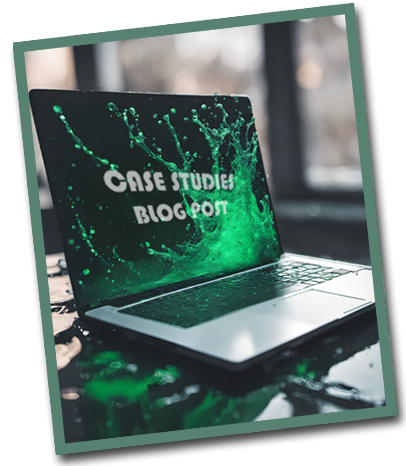
The sample blog post here includes three curated case studies of businesses that have recovered innovatively from social media setbacks. Case studies have perennial appeal. People love stories – especially, those with happy endings.
From the point of view of content comprehension, research suggests that case studies provide roadmaps that others have used successfully to solve problems – and your reader can gain faster from the challenges, experiments, and insights of others.

After you see this portfolio sample below, click here to get back to the Portfolio Index page.
“Case Studies Blog Posts” stand as some of the most potent tools in content marketing, offering a blend of storytelling and factual validation. At their core, case study blog posts chronicle a real-world problem faced by a client or a business, detailing the steps taken to address that challenge and the results obtained.
Through this narrative, they offer a tangible testament to the effectiveness of a brand’s solutions, methodologies, or products.
The benefits to brands employing case study blog posts are multifaceted. Firstly, they provide tangible proof of a brand’s claims, substantiating marketing messages with tangible outcomes. This not only reinforces brand credibility but also instills trust among potential clients or customers.
Moreover, case studies offer relatable narratives; businesses facing similar challenges can see themselves in the described scenarios, making the brand’s solutions personally relevant.
This relatability can drive engagement and conversions, with readers more inclined to explore the presented solution for their own needs.
However, producing a compelling case study blog post has unique challenges. To start, the brand must select cases that genuinely reflect its capabilities without overstating results. Authenticity is crucial.
Furthermore, while the narrative is vital, it’s equally important to maintain a factual tone, ensuring the content doesn’t appear promotional but rather informative and genuine. Presenting data and results clearly and compellingly without overwhelming the reader with technical jargon is another challenge to navigate.
Case Studies Blog Posts are impactful testimonials of a brand’s prowess, offering readers a blend of story and substance.
When articulated with precision, authenticity, and clarity, they can be instrumental in positioning a brand as a reliable solution provider, directly influencing purchasing or collaboration decisions.
Read on …

Your brand, company, or even personal reputation online – especially on the social media – takes effort to create via a deliberate proactive PR strategy. After that, you need attentive monitoring, risk management, commitment, and attention.
But as some brands know, despite all the care taken, one wrong step is all it takes to wreak havoc on a hard-built good name.
But take heart, there’s a very good and relatively speedy way to repair reputations that have had setbacks. If you can “imagineer” an unexpected response, you can bounce back with bigger gain than before. The examples below will prove that to you.
I have picked up three different cases of horrendous reputation damage and subsequent grand brand recovery to show you how well some brands have “risen from the ashes”.
Curiously, you will see that all three cases had something to do with the brands getting hijacked on the social media. That’s why, I think, brands have to be extraordinarily careful of the social channels, and especially with their own staff or consumers.
Once you allow the social world to take control of your reputation, it all speeds up so fast that you will never perhaps be able to catch up with the “reputation-runaway”.
The moral of the story from the three cases below – and the way to recover from online reputation loss – is actually by not making the mistake of “defending”. That is absolutely the wrong way to respond, because it suggests you have something to defend.
Instead give thought to what new positive “unexpected response” you can revert with – and give it a tremendous new Digital PR push. Make the reputation setback look like a small blip when compared to the “bigness” that your company stands for.
A big social media story broke in 2012. It was the complete beating McDonald’s got when it launched its Twitter campaign called #McDStories.
The whole issue started when McDonald’s changed from its first hashtag #MeetTheFarmers, which had been set up to attract uplifting farmer stories from users. Since the #MeetTheFarmer campaign was found to be really successful, the brand then became tempted to ambitiously attempt a larger version of the same success format.
The company spent on paid hashtags to launch a whole new #McDStories campaign on Twitter – intending that brand fans would use it to share their love of the product and the company.
Unfortunately, the hashtag was totally hijacked by brand haters, who started prolifically recounting their tales of disappointment and dissatisfaction with the McDonald’s brand. All in all the #McDStories was a complete PR disaster.
Rick Wion, Social Media Director of McDonald’s said it all: “One thing is for sure. You cannot fire fight these things. When a hashtag goes, it is gone.”
Introspection, however, led the company to actually hit upon an enormous insight that could create immense potential for future Twitter success.
McDonald’s realized that if it could allow users to participate with questions (rather than asking for feedback) the company could then control the answers to those user questions in a way that could show the brand as a hero. What an awesome insight!
The idea was born was to see if users could be asked to submit their questions about the brand, which the company could then answer in a way most flattering to the brand … instead of the company asking the open-ended questions with the users responding with less-than-flattering answers.
A new Twitter campaign called “Our Food: Your Questions” was launched in which the company even shone through as truthful and transparent.
One social media user tested the company’s authenticity with particularly uncomfortable questions, but recollects that: “McDonald’s Canada told the truth about its food on its web site. It may not make you a customer but you have to admire their openness.” It was a coup.
In a small North Carolina-based Domino’s franchise two disgruntled employees posted a prank video of some very unhygienic and awful food-preparation practices in their restaurant. Unfortunately, with the sheer reach and speed of social media, there were more than a million views on YouTube within a couple of days – and Twitter went viral and berserk.
Domino’s were so unprepared and taken aback, I guess, they worsened the whole thing by responding a bit too late. It was 48 hours before the video was brought down on YouTube.
But one great thing came of it. President Patrick Doyle took to the same YouTube to apologize with deep honesty.
His demeanor and, obviously, his words were very heartfelt. He came through as pained when he said in his speech: “It sickens me to think that two individuals can impact our great system, where 125,000 men and women work for local business owners.”
What Patrick Doyle had achieved on the social media was to get the collective conscience of the social crowd respond to the hurt this “fun” had caused the well-meaning and dedicated workforce of Domino’s.
That touched a chord. The pranksters had used YouTube to create havoc. Patrick Doyle used YouTube to show soul. This story shows us that the social world reacts as much to entertainment as to deep emotion!
The even better part of the story is what followed the disaster. The company has now put four practices into place as a fortification against loss of reputation – either accidentally or through anybody’s deliberate action.
They have a policy now that stresses on the importance of a media crisis team; they have built a system with the ability to listen to and track real-time social developments; they have addressed their deficiencies in being able to respond quickly; and finally, they are paying a lot more attention to preventative care rather than crisis response.
Unlike McDonald’s, who took the battle back to the social channels, Domino’s have chosen to re-engineer their own mindsets and internal systems.
Oh My God … Twitter went mad when a US Airways staffer accidentally posted a pornographic picture of herself. Within seconds it was all over the social world. How embarrassing is that for a company, no matter how funny it was to the Twitterati!
The mistake was so huge and miserable that The Wire called it the “All-Time First Place Victor in Worst Corporate Social Media #Brand Strategy”.
The tweet was of course quickly deleted, and due apologies were announced, but the “photo” was live on the US Airway’s Twitter account for at least an hour – and in the Internet world that’s long enough to tear the reputation of the Airline to shreds.
PR pundits were all abuzz … asking whether it is a bigger disaster for a brand to be bad-mouthed for something globally frightful (like an oil-spill) than to be the butt of jokes (like posting a “naughty pic”).
Such ridicule and derision seems somehow to imply that the brand may have poor internal governance, and reduces the brand to a smallness, doesn’t it?
But look how smartly US Airways handled the situation. Word was out that the “embarrassing employee” would be sacked, but the company did not do the expected.
Instead, it issued a statement that it was standing by its people, and since anyone could make an honest mistake, it understood and was forgiving. The social world had no option but to follow suit – and the matter was thus ended on a note of “let’s forgive and forget”.
The label of silliness and smallness that had come upon the brand after the horrendous photo-posting was overcome by the largeness of heart the company showed forcing everyone else to be “bigger than the event”.
Of course, after that, there was a lot of internal course correction also. The company was using its own proprietary social management systems that needed to be tweaked to prevent such disasters from accidentally happening.
It was also imperative for the company to ensure that work and personal devices were not interchangeably used by the social media management staff, such that their personal files can get into their work folders. That’s a lesson we all know but never follow, do we?
It’s ideal to start your online reputation management initiative before you have any online reputation problems. If you take a preventive and proactive approach, you will be able to monitor your reputation more easily because you would have set the criteria that should become your alarm bells.
In many cases, companies, marketers, and brands are often the last to know when their reputations have been shred, because they either do not stay alert – or worse, they cannot recognize disasters fast enough when they see them.
Every brand runs the risk of mistrust, loss of credibility, loss of goodwill, unpleasant reverberations from the audience, and loss of interest from stakeholders. There’s no real insurance against “goodwill loss” even if insurance companies do often include this idea.
But, as the wise say, bad results can sometimes lead to states of gain far better than before. The lessons we have to learn from great brands is that it’s not just how you do “damage control” that sets you apart. It’s how you do spectacular and imaginative recoveries via entirely unexpected responses that show your brand’s leadership caliber and establish your pedigree on a new level.
Develop the mindset to turn your worst disasters into diamonds.
Delve deeper into the tangible results of my unique approach by exploring my service spectrum, my case studies, and other items in my portfolio. Each piece is a testament to the harmony of experience, an unconventional mindset, and cross-sector adeptness.
If you’re eager to elevate your brand’s narrative and strategy, don’t hesitate to tap into this wealth of knowledge.

"As a Content/Brand Specialist, and SEO/UX Writer, I can help transform your brand's online presence. I can lift it with innovative ideas to take it to an enviable position. Let's collaborate to create a captivating brand story, engage your audience, boost your online visibility, and increase your ROI. Take the next step towards your brand content success and contact me today."
Shobha Ponnappa
I Bring You:
Content Marketing That’s “Unusual By Strategy” … Tips, Tricks, Tactics, Techniques, Trends, Training.
Get my weekly ContenTracker Newsletter packed with loads of content marketing ideas – proven and unusual.
Get a free download of my ebook on “50 Unusual Ways To Use AI In Content Marketing” … and transform your success.

Just fill in the form to join my community … we have big and small brands for company. You’ll stay on the speedway to growth.
KEY TOPIC CATEGORIES COVERED ON THIS SITE:
COPYRIGHT © 2024. SHOBHAPONNAPPA.COM. ALL RIGHTS RESERVED.